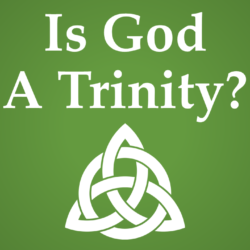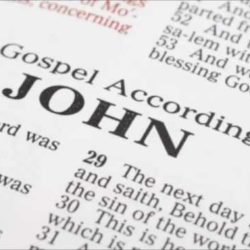Last time we considered Jesus’ identity as God’s messiah. Today, we’ll look at a number of texts that are sometimes misunderstood to teach that Jesus is God. We’ll go through three classifications of verses: (1) those with manuscript issues, (2) those with translation issues, and (3) those with interpretation issues. Here is the breakdown.
Manuscript Issues: 1 Timothy 3.16, 1 John 5.7-8
Translation Issues: Acts 20.28, Romans 9.5, Titus 2.13, 2 Thessalonians 1.12, 2 Peter 1.1
Interpretation Issues: John 5.18, John 10.30, 1 John 5.20, Colossians 2.9
See below for links to the various handouts mentioned in this episode.
—— Notes ——
State the Doctrine Simply
Jesus is God’s human messiah—a man attested to you by God with mighty works and wonders and signs that God did through him in your midst (Acts 2.22).
Texts that Support This Teaching
Ex 8.10; 19.16-20; 20.1-6; Deut 4.35-39; 5.1-7; 6.4-5; 7.9-10; 10.17-21; 32.12, 39; 1 Sam 2.2; 2 Sam 7.22-24; 1 Kings 8.60; 2 Kings 19.15, 19; 1 Chron 17.20; Neh. 9.6; Ps. 83.18; 86.9-10; 135.5; Is 37.16, 20; 41.4; 42.5-8; 43.10-13; 44.6-8, 24; 45.5-7, 12, 18, 21-22; 46.9; Jer 10.7-10; Joel 2.27; Zech 14.9; Mat. 19.17; Mk 10.17-18; 12.28-33; Jn 5.44; 8.41; 17.3; 1 Cor 8.4-6; Gal 3.20; Eph 4.6; 1 Tim 2.5; Jam 2.19; Jud 25
Difficult Texts
Before examining these texts, we should note how even Trinitarians have sometimes observed what a shaky foundation their belief in the deity of Christ rests:
Christopher Kaiser:
“Belief in the deity of Christ has traditionally been the keystone of the doctrine of the Trinity, yet explicit references to Jesus as ‘God” in the New Testament are very few, and even those few are generally plagued with uncertainties of either text or interpretation.”[1]
William Barclay:
“But we shall find that on almost every occasion in the New Testament on which Jesus seems to be called God there is a problem either of textual criticism or of translation. In almost every case we have to discuss which of two readings is to be accepted or which of two possible translations is to be accepted.”[2]
Manuscript Issues
1 Timothy 3.16 [NKJ]
16 And without controversy great is the mystery of godliness: God was manifested in the flesh, Justified in the Spirit, Seen by angels, Preached among the Gentiles, Believed on in the world, Received up in glory.1 Timothy 3.16 [ESV]
16 Great indeed, we confess, is the mystery of godliness: He was manifested in the flesh, vindicated by the Spirit, seen by angels, proclaimed among the nations, believed on in the world, taken up in glory.ὅς {A}
The reading which, on the basis of external evidence and transcriptional probability, best explains the rise of the others is ὅς. It is supported by the earliest and best uncials (א* A*vid C* Ggr) as well as by 33 365 442 2127 syrhmg, pal goth ethpp Origenlat Epiphanius Jerome Theodore Eutheriusacc. to Theodoret Cyril Cyrilacc. to Ps-Oecumenius Liberatus. Furthermore, since the neuter relative pronoun ὅ must have arisen as a scribal correction of ὅς (to bring the relative into concord with μυστήριον), the witnesses that read ὅ (D* itd, g, 61. 86 vg Ambrosiaster Marius Victorinus Hilary Pelagius Augustine) also indirectly presuppose ὅς as the earlier reading. The Textus Receptus reads θεός, with אe (this corrector is of the twelfth century) A2 C2 Dc K L P Ψ 81 330 614 1739 Byz Lect Gregory-Nyssa Didymus Chrysostom Theodoret Euthalius and later Fathers. Thus, no uncial (in the first hand) earlier than the eighth or ninth century (Ψ) supports θεός all ancient versions presuppose ὅς or ὅ and no patristic writer prior to the last third of the fourth century testifies to the reading θεός. The reading θεός arose either (a) accidentally, through the misreading of ΟC as ΘC, or (b) deliberately, either to supply a substantive for the following six verbs, or, with less probability, to provide greater dogmatic precision.
1 John 5.7-8: Comma Johanneum
| King James Version (1611) | English Standard Version (2008) |
| 7 For there are three that beare record in heauen, the Father, the Word, and the holy Ghost: and these three are one. 8 And there are three that beare witnesse in earth, the Spirit, and the Water, and the Blood, and these three agree in one. | 7 For there are three that testify:
8 the Spirit and the water and the blood; and these three agree. |
| Luther’s Translation (1545) | German Schlachter Version (1951) |
| 7 Denn drei sind, die da zeugen im Himmel: der Vater, das Wort und der Heilige Geist; und diese drei sind eins. 8 Und drei sind, die da zeugen auf Erden: der Geist und das Wasser und das Blut; und die drei sind beisammen. | 8 Denn drei sind es, die bezeugen:
der Geist und das Wasser und das Blut, und die drei sind einig. |
| Nova Vulgata (1986) | |
| Quia tres sunt, qui testificantur: Spiritus et aqua et sanguis; et hi tres in unum sunt. | For there are three who testify: the Spirit and the water and the blood; and these three are in agreement. |
| Clementine Vulgate (1589) | |
| Quoniam tres sunt, qui testimonium dant in caelo: Pater, Verbum, et Spiritus Sanctus: et hi tres unum sunt. Et tres sunt, qui testimonium dant in terra: spiritus, et aqua, et sanguis: et hi tres unum sunt. | Indeed there are three who give testimony in heaven: the Father, the Word, and the Holy Spirit: and these three are one. And there are three who give testimony on earth: the spirit, and the water, and the blood: and these three are one. |
| Stuttgart Vulgate (1983, critical reconstruction from earliest and best manuscripts) | |
| quia tres sunt qui testimonium dant Spiritus et aqua et sanguis et tres unum sunt | For there are three who give testimony: the Spirit and the water and the blood and the three are one. |
| Greek Orthodox New Testament (1904) | |
| ὅτι τρεῖς εἰσιν οἱ μαρτυροῦντες ἐν τῷ οὐρανῷ, ὁ Πατήρ, ὁ Λόγος καὶ τὸ Ἅγιον Πνεῦμα, καὶ οὗτοι οἱ τρεῖς ἕν εἰσι·καὶ τρεῖς εἰσιν οἱ μαρτυροῦντες ἐν τῇ γῇ, τὸ Πνεῦμα καὶ τὸ ὕδωρ καὶ τὸ αἷμα, καὶ οἱ τρεῖς εἰς τὸ ἕν εἰσιν | for there are three who testify in heaven, the Father, the Word and the Holy Spirit, and these three are one; and there are three who testify in earth, the Spirit and the water and the blood, and the three are in agreement. |
| Stephanus/Received Text (1550) | |
| ὅτι τρεῖς εἰσιν οἱ μαρτυροῦντες εν τῷ οὐρανῷ, ὁ πατήρ, ὁ λόγος, καὶ τὸ Ἅγιον Πνεῦμα· καὶ οὗτοι οἱ τρεῖς ἕν εἰσιν καὶ τρεῖς εἰσιν οἱ μαρτυροῦντες ἕν τῇ γῇ, τὸ πνεῦμα καὶ τὸ ὕδωρ καὶ τὸ αἷμα καὶ οἱ τρεῖς εἰς τὸ ἕν εἰσὶν | for there are three who testify in heaven, the Father, the Word, and the Holy Spirit; and these three are one and there are three who testify on earth, the spirit and the water and the blood and the three are in agreement. |
| Erasmus (1522) | |
| ὅτι τρεῖς ἐισιν ὁι μαρτυροῦντες ἑν τῷ ὁυρανῷ, πατὴρ, λόγος, καὶ πνεῦμα ἅγιου, καὶ οὗτοι ὁι τρεῖς ἕν ἐισι. καὶ τρεῖς ἐισιν ὁι μαρτυροῦντες ἐν τῇ γῇ, πνεῦμα, καὶ ὕδωρ, καὶ αἷμα, καὶ ὁι τρεῖς εἰς τὸ ἕν ἐισιν. | for there are three who testify in heaven, father, word, and holy spirit, and these three are one. And there are three who testify on earth, spirit, and water, and blood, and these three are in agreement. |
| Erasmus (1519) | |
| ὅτι τρεῖς ἐισιν ὁι μαρτυροῦντες, τὸ πνεῦμα, καὶ τὸ ὕδωρ, καὶ τὸ ἇιμα, καὶ ὁι τρεῖς ἐις τὸ ἕν ἐισιν. | for there are three who testify, the spirit, and the water, and the blood, and the three are in agreement. |
| Nestle Aland 27th Edition (1993, critical reconstruction from earliest and best manuscripts) | |
| ὅτι τρεῖς εἰσιν οἱ μαρτυροῦντες, τὸ πνεῦμα καὶ τὸ ὕδωρ καὶ τὸ αἷμα, καὶ οἱ τρεῖς εἰς τὸ ἕν εἰσιν. | for there are three who testify, the spirit and the water and the blood, and the three are in agreement. |
| Greek Manuscripts Containing the Comma in the Margin | |||
| # | name | original date | date of marginal note |
| 221v.r. | manuscript in Bodleian Library at Oxford | 10th c. | 15th/16th c. |
| 88v.r. | codex Regius of Naples | 14th c. | 16th c. |
| 429 v.r. | manuscript at Wolfenbüttel | 14th/15th c. | 16th c. |
| 636 v.r. | manuscript at Naples | 16th c. | 16th c. |
For my paper on the Comma Johanneum, click here.
Translation Issues
Acts 20.28 [ESV]
Pay careful attention to yourselves and to all the flock, in which the Holy Spirit has made you overseers, to care for the church of God, which he obtained with his own blood.Acts 20.28 [NRSV]
Keep watch over yourselves and over all the flock, of which the Holy Spirit has made you overseers, to shepherd the church of God that he obtained with the blood of his own Son.
This verse sounds like God or the Holy Spirit purchased the church with his blood. However, the grammar of the verse could go two ways. The Greek literally reads “which he purchased with the blood of his own.” Some translators see the word “son” implied here and so the NRSV translates it “that he obtained with the blood of his own Son.” Besides does God have blood anyhow?
Raymond Brown:
“Grammatically [the] reading raises the possibility that the passage is referring to Jesus as God who obtained the church “with his own blood.” However, there is another possibility: Perhaps “God” refers to the Father and “his own” refers to the Son; thus, “the church of God (the Father) which He obtained with the blood of His own (Son).” Many favor this interpretation or an alternative: “the church of God which he (Christ) obtained with his own blood,” positing an unexpressed change of subject. And so, even when we read “the church of God,” we are by no means certain that this verse calls Jesus God.”[13]
Romans 9.5 [ESV]
To them belong the patriarchs, and from their race, according to the flesh, is the Christ, who is God over all, blessed forever. Amen.Romans 9.5 [NASB]
Whose are the fathers, and from whom is the Christ according to the flesh, who is over all, God blessed forever. Amen.Romans 9.5 [NAB]
theirs the patriarchs, and from them, according to the flesh, is the Messiah. God who is over all be blessed forever. Amen.
This verse can be translated three different ways depending on whether or not the translator thinks that Jesus is “God blessed forever” or if he thinks that Paul ended with the thought “Christ according to the flesh” and began a new sentence with “God who is over all be blessed forever” or that Christ is “God over all” as in “Christ, who is God over all, blessed forever.” For example, here is the RSV: “to them belong the patriarchs, and of their race, according to the flesh, is the Christ. God who is over all be blessed for ever. Amen.” This is just another instance where the Greek can be translated different ways depending on the translator’s bias.
Schneider:
Rom. 9.5 is disputed. After Paul has expounded the position of Israel in salvation history and has emphasized as an especial advantage the fact that Christ according to the flesh, stems from this people, he adds a relative clause, which runs lit. “who is over all God blessed for ever. Amen.” Even so, Christ would not be equated absolutely with God, but only described as a being of divine nature, for the word theos has no article. But this ascription of majesty does not occur anywhere else in Paul. The much more probable explanation is that the statement is a doxology directed to God, stemming from Jewish tradition and adopted by Paul. Overwhelmed by God’s dealings with Israel, Paul concludes with an ascription of praise to God. The translation would then read, “The one who is God over all be blessed for ever. Amen.” or alternatively, “God who is over all be blessed for ever. Amen.”[14]
The NAB footnote says:
Some editors punctuate this verse differently and prefer the translation, “Of whom is Christ according to the flesh, who is God over all.” However, Paul’s point is that God who is over all aimed to use Israel, which had been entrusted with every privilege, in outreach to the entire world through the Messiah.
See also Metzger who likes the ESV rendering, but recognizes the validity of the other two.
Titus 2.13 [ESV]
waiting for our blessed hope, the appearing of the glory of our great God and Savior Jesus Christ,Titus 2.13 [NAB]
as we await the blessed hope, the appearance of the glory of the great God and of our savior Jesus Christ
Frances Young:
It is sometimes said that he [Jesus] is called God in Romans 9.5; 2 Thessalonians 1.12; and Titus 2.13; but it is more likely that the first is pious ejaculation unconnected with the syntax of the sentence;… that in the second and third, the Greek is rather loose and in fact refers (in the former) to the grace of God plus the grace of the Lord Jesus Christ, and (in the latter) to the glory of our great God and of our Savior Jesus Christ.[15]
Jason David BeDuhn:
“Those who defend translations that read as if only Jesus is spoken of in both Titus 2.13 and 2 Peter 1.1 attempt to distinguish those two passages from the parallel examples I have given by something called “Sharp’s Rule.” In 1798, the amateur theologian Granville Sharp published a book in which he argued that when there are two nouns of the same form (“case”) joined by “and” (kai), only the first of which has the article, the nouns are identified as the same thing. Close examination of this much used “rule” shows it to be a fiction concocted by a man who had a theological agenda in creating it, namely to prove that the verses we are examining in this chapter call Jesus “God.””[16]
“We have no sure way to judge which translations correctly understand the verse and which ones do not. But with the long overdue dismissal of the phantom of “Sharp’s Rule,” the position of those who insist “God” and “Savior” must refer to the same being in this verse is decidedly weakened. There is no legitimate way to distinguish the grammar of Titus 2.13 from that of Titus 1.4 and 2 Thessalonians 1.12, just as there is no way to consider 2 Peter 1.1 different in its grammar from 2 Peter 1.2. This is a case where grammar alone will not settle the matter. All we can do is suggest, by analysis of context and comparable passages, the “more likely” and “less likely” translations, and leave the question open for further light.”[17]
2 Peter 1.1 [ESV]
Simeon Peter, a servant and apostle of Jesus Christ, To those who have obtained a faith of equal standing with ours by the righteousness of our God and Savior Jesus Christ:2 Peter 1.1 [ASV]
Simon Peter, a servant and apostle of Jesus Christ, to them that have obtained a like precious faith with us in the righteousness of our God and the Saviour Jesus Christ:”
Patrick Navas:
“The grammatical structure of 2 Peter 1.1 is similar to Titus 2.13. The MacArthur Study Bible states: “The Gr. Construction has only one article before this phrase, making the entire phrase refer to the same person. Thus, Peter is identifying Jesus as both Savior and God.” However, it was observed by Dr. Nigel Turner in A Grammar of New Testament Greek (Moulton-Turner, 1963): “The repetition of the article was not strictly necessary to ensure that the items be considered separately.” And in another place: “Unfortunately, at this period of Greek we cannot be sure that such a rule [regarding the article] is really decisive. Sometimes the definite article is not repeated even where there is clearly a separation in idea.”
Numerous other translations (as in the case of Titus 2.13) render the verse so that both God the Father and Jesus Christ are in view. Not only is this way of translating the verse grammatically legitimate, but the very next verse distinguishes between the two so that contextually one finds added reason for doing so. Verse two reads: “Grace and peace be multiplied to you in the knowledge of God and of Jesus our Lord” (NASB). Although arguably not decisive (when the grammar is considered independently), such a fact cannot by any means be set aside as irrelevant. This may be why the footnote on 2 Peter 1.1 in the Catholic New American Bible acknowledges: “The words translated our God and Savior Jesus Christ could also be rendered ‘Our God and the savior Jesus Christ.’” Several other translations also call Jesus God in this instance but are careful to inform their readers about the alternative rendering [including Rotherham’s Emphasized Bible, the RV, RSV, NRSV, and the Jerusalem Bible].”[18]
2 Thessalonians 1.12 [ESV]
so that the name of our Lord Jesus may be glorified in you, and you in him, according to the grace of our God and the Lord Jesus Christ.2 Thessalonians 1.12 [NET]
that the name of our Lord Jesus may be glorified in you, and you in him, according to the grace of our God and the Lord Jesus Christ.”
Raymond Brown:
“There are two possible interpretations of the Greek genitives: (a) “the grace of our God-and-Lord Jesus Christ”; (b) “the grace of our God and of the Lord Jesus Christ.”
The first interpretation, which gives Jesus the title “God,” is favored by the absence in the Greek of an article before “Lord,” creating the impression that the two genitives are bound together and governed by the one article that precedes “God.” Yet, the exact three-word Greek combination for “God and Lord” is not found elsewhere in the Bible in reference to one person; and perhaps “Lord Jesus Christ” was so common a phrase that it would automatically be thought of as a separate entity and could be used without the article. The second interpretation is favored by the fact that pronominal “of us” (= “our”) separates the two titles; but, as we shall see below in discussing 2 Pet. 1.1; this is not a decisive argument. The most impressive argument for the second interpretation is that “our God” occurs four times in 1 and 2 Thessalonians as a title for God the Father. By analogy in the passage at hand, then, “our God” should be distinguished from “(the) Lord Jesus Christ,” as most commentators acknowledge. Thus this text cannot be offered as an example of the use of the title “God” for Jesus.”[19]
Interpretation Issues
John 5.18
18 This was why the Jews were seeking all the more to kill him, because not only was he breaking the Sabbath, but he was even calling God his own Father, making himself equal with God.
Two facts must be considered: (1) It is the unbelieving Jews who misunderstand Jesus and think he is claiming to be equal with God. Did Jesus think he was equal with God? John 10.29 and 14.28 both indicate that he believed his Father was greater than him. The misunderstanding of Jesus by the hard-hearted religious leaders is a theme which runs throughout the Gospel of John. We dare not align ourselves on the side of Jesus’ critics. (2) The very next verse answers how Jesus related to the Father. He starts by saying, “the Son can do nothing of Himself, unless it is something He sees the Father doing” (John 5.19). By calling God his Father he was not claiming equality with God. When you call God your Father does that mean you think you are equal with him? Of course not!
1 John 5.20
20 And we know that the Son of God has come and has given us understanding, so that we may know him who is true; and we are in him who is true, in his Son Jesus Christ. He is the true God and eternal life.
Joh. Ed. Huthe:
“As is well known, views have differed from old times about the meaning of outoj. While the Arians understand outoj of God, the orthodox refer it to the immediately preceding en tw uiw ‘I. Cr., and use this passage as a proof of the divinity of the Son. This interpretation remained the prevailing one in the church…and against this the Socinians, and then Grotius, Wetstein, the English Anti-Trinitarians, and the German Rationalists followed the opposite view…The dispute cannot be settled on grammatical lines, for outoj can be referred both to ton alhqinon and also to tw uiw…The former reference…is supported by the expression: o alhqinoj qeoj; for, in the first place, it is more natural to understand here the same subject as is previously designated by o alhqinoj, than any other; and, in the second place, the Father and the Son, God and Jesus Christ, are always so definitely distinguished throughout the whole Epistle, that it would be strange if, at the close of it, and, moreover, just after both subjects have been similarly distinguished immediately before, Christ—without further explanation, too—should be described as o alhqinoj qeoj, especially as this designation is never ascribed to the Son in the writings of John, definitely though the divinity of the Son is taught in them.”[20]
Glen W. Barker:
“He” in 20b is literally “this one” (houtos)…Grammatically the pronoun most naturally refers to Jesus Christ. Westcott, (p. 187) however, argues that in terms of subject emphasis it more naturally refers backwards to God, who earlier in the text was designated as the one who is true (20a): “This Being—this One who is true, who is revealed through and in His Son, with whom we are united by His Son—is the true God and life eternal.” Stott supports Westcott, noting that all “three references to ‘the true’ are to the same Person, the Father, and the additional points made in the apparent final repetition are that it is this One, namely the God made known by Jesus Christ, who is the true God, and that, besides this, He is eternal life. As He is both light and love (i.5, iv.8), so He is also life” (Stott, p. 196; cf. Brooke, pp. 152-53; Dodd, Johanine Epistles, p.140).[21]
John W. Stott:
“The final sentence of verse 20 runs: He is the true God and eternal life. To whom does he refer? Grammatically speaking, it would normally refer to the nearest preceding subject, namely his Son Jesus Christ. If so, this would be the most unequivocal statement of the deity of Jesus Christ in the New Testament, which the champions of orthodoxy were quick to exploit against the heresy of Arius. Luther and Calvin adopted this view. Certainly it is by no means an impossible interpretation. Nevertheless, ‘the most natural reference’ (Westcott) is to him who is true. In this way the three references to ‘the true’ are to the same person, the Father, and the additional points made in the apparent final repetition are that it is this one, namely the God made known by Jesus Christ, who is both the true God and eternal life. As he is both light and love (1.5; 4.8), so he is also life, himself the only source of life (Jn. 5.26) and the giver of life in Jesus Christ (11). The whole verse is strongly reminiscent of John 17.3, for there as here eternal life is defined in terms of knowing God, both Father and Son.”[22]
John 10.30
I and the Father are one.
The context focuses on how Jesus is the good shepherd (in contrast to the bad shepherds of Ezekiel 34). Jesus had just said that, as the shepherd, he keeps the sheep so that no wolf or thief could snatch them (John 10.27-28). The next verse says that the Father (who is greater than all) keeps the sheep so that no one can snatch them out of His hand (John 10.29). Thus, the Son and the Father are one in that they are both working to keep the sheep (John 10.30). This has nothing to do with substance or equality. Furthermore, it is clear that the Father is greater than all because he gave the flock to the Son. In addition, we are to have the same sort of oneness that the Father shares with the Son (John 17.20-22). The oneness that the Father and Son share is to be shared by the disciples as well.
Colossians 2.9
9 For in him [Christ] the whole fullness of deity dwells bodily
We know that “God was in Christ reconciling the world to himself” (2 Cor 5.19 NASB). That God was in Christ doesn’t make Christ God. Never has someone been so transparent to God working within him or her than Jesus of Nazareth. Look at how Jesus talks about his relationship to the Father at the Last Supper:
John 14.8-11
8 Philip said to him, “Lord, show us the Father, and it is enough for us.” 9 Jesus said to him, “Have I been with you so long, and you still do not know me, Philip? Whoever has seen me has seen the Father. How can you say, ‘Show us the Father’? 10 Do you not believe that I am in the Father and the Father is in me? The words that I say to you I do not speak on my own authority, but the Father who dwells in me does his works. 11 Believe me that I am in the Father and the Father is in me, or else believe on account of the works themselves.
Furthermore, we too should pray that God would fill us as well as Paul exemplifies:
Ephesians 3.14-19
14 For this reason I bow my knees before the …16 that …he may grant you… 19 …to know the love of Christ that surpasses knowledge, that you may be filled with all the fullness of God.
[1] Christopher B. Kaiser, The Doctrine of God, A Historical Survey, (London: Marshall Morgan & Scott, 1982), p. 29.
[2] William Barclay, Jesus as They Saw Him, (Grand Rapids: Eerdmans, 1978), p. 21.
[3] Jerry H. Bentley, “Erasmus, Jean Le Clerc, and the Principle of the Harder Reading” in the Renaissance Quarterly, vol. 31, no. 3 (Autumn 1978), The University of Chicago Press, p. 313.
[4] Joseph M. Levine, “Erasmus and the Problem of the Johanine Comma” in the Journal of the History of Ideas, vol. 58, no. 4 (October 1997), University of Pennsylvania Press, p. 582.
[5] Charles G. Nauert, “Humanism as Method: Roots of Conflict with the Scholastics” in The Sixteenth Century Journal, vol. 29, no. 2 (Summer 1998), The Sixteenth Century Journal, p. 434.
[6] Erasmus to Dorp, c. May, 1515, CWE, no. 337, III, 111-39, quoted from Levine, p. 583-4.
[7] Another example was his addition of the words “nor the son” in Matthew 24.36, which he later also withdrew.
[8] Nauert, p. 436.
[9] Bentley, p. 315.
[10] ibid.
[11] LB IX, 275 B-C, quoted in Levine, p. 588.
[12] ibid., 589.
[13] Brown, An Introduction to New Testament Christology, pp 177-178.
[14] J. Schneider, “God” in The New International Dictionary of New Testament Theology, vol. 2, ed. Colin Brown, (Grand Rapids: Zondervan, 1976), p. 80.
[15] Frances Young, The Myth of God Incarnate, ed. by John Hick, (Philadelphia: The Westminster Press, 1977), p. 44 (fn. 21).
[16] Jason David BeDuhn, Truth in Translation: Accuracy and Bias in English Translations of the New Testament, (Lanham, MD: University Press of America, 2003), p. 92.
[17] Ibid., p. 94.
[18] Patrick Navas, Divine Truth or Human Tradition?, (Bloomington, IN: AuthorHouse, 2007), pp. 298-299.
[19] Ibid., p. 180.
[20] Joh. Ed. Huthe, Th. D., Meyer’s Commentary on the New Testament, 1884, pp. 622-623.
[21] Glen W. Barker, The Expositor’s Bible Commentary, ed. by Frank E. Gaebelein, (Grand Rapids: Zondervan, 1982), p. 357.
[22] John W. Stott, Tyndale New Testament Commentaries: The Letters of John (Revised Edition), (Grand Rapids: Eerdmans, 1998), pp. 197-198.
[23] One God and One Lord, Appendix A
—— Links ——
- For the handout on 1 John 5.7, see The Story Behind The Comma Johanneum
- For the handout with numerous texts in it, see Appendix 2 in Jesus is God: Exploring the Notion of Representational Deity
- See other episodes in this Theology Class
- Find more Restitutio classes here
- Intro music: Jazzy Frenchy by bensound.com. Licensed under Creative Commons: By Attribution 3.0 License.








hey, great work thanks so much for putting this out there! Can you lock the audio thingy up the top of page so when we spool down the page to peruse the notes, we can still pause/restart sound etc easier? 🙂